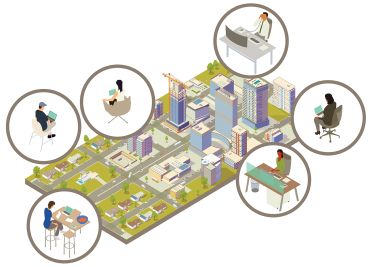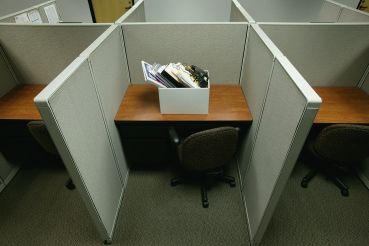Q&A: Skanska’s Mark Carroll On Future-Proofing DC Office Property
By Keith Loria October 20, 2020 8:43 am
reprints
Living in an unprecedented time, commercial real estate professionals are facing a pivotal moment in their industry as many are forced to rethink the ways in which their buildings will operate and adapt to a post COVID-19 environment.
Not only is Skanska one of the world’s leading construction and development companies, but it’s noted for building health-conscious and sustainable buildings that enhance the safety and well-being of occupants.
Take 2112 Penn, a LEED Gold-certified, 230,000-square-foot trophy office building in downtown Washington, D.C. The building earned credits for indoor chemical and pollutant source control and increased ventilation thanks to a high level of filtration from MERV 13 filters and an HVAC system that provides 30 percent more outdoor air than nCode requires, ultimately lowering viral count.
Still, Skanska is taking additional precautions at the property, including utilizing an aerosol-based disinfectant system for common areas, implementing touchless access features, and using ultraviolet germicidal irradiation (UVGI) technology throughout the building.
Mark Carroll, executive vice president of Skanska USA Commercial Development in Washington, D.C., spoke to Commercial Observer about future-proofing 2112 Penn, implementing touchless technology, and the company’s philosophy of building with health and wellness in mind.
Commercial Observer: First off, how has the company fared during the pandemic? How has it impacted Skanska overall?
Mark Carroll: The company is doing well. We know that year to year the marketplace will be different, and none of us could predict the impact COVID-19 would have on our industry. Luckily, Skanska’s business model has positioned us for disruptions. We have three business lines, Building Construction, Civil Construction, and Commercial Development—which is what I lead here in Washington, D.C.
Because Skanska Commercial Development is self-financed, we have control over the start and stop of projects as well as the flexibility to make quick changes when we deem necessary. We are taking this opportunity to re-evaluate and prepare for a new normal when the pandemic is resolved and advance our projects to best position them for success at delivery. That includes looking at future project pursuits and incorporating the latest health and safety technologies that can be integrated into a building.
Can you take me through the challenges that COVID presented?
It is unsettling not knowing when this will end. Skanska has a deep commitment to sustainability and to creating a healthy environment for companies, its employees, as well as our own people. The pandemic has forced us to rethink, restructure, and accelerate health, safety and innovation challenges that better reflect the new and future demands that tenants have.
We always strive to adapt but also drive the expectations in the market, and, in times like these, a lot of new insights will be generated and need to be implemented faster than before. Now more than ever, we are looking for and incorporating solutions to make sure our offices are safe environments for those employers to return to once they are ready to do so.
What’s happening at 2112 Penn? Talk about some of the innovative solutions and technologies you are utilizing to improve this office property with COVID in mind?
2112 Penn, like all Skanska Commercial Development projects, was developed with sustainability and innovation at the forefront. Fortunately, that positioned the building well to meet COVID-19 safety challenges. For instance, the HVAC system we placed in the building provides 30 percent more outdoor air than code requires, lowering viral count.
Since the pandemic began, touchless access features have been added in the building that can help limit the spread of these types of viruses and are a step toward a healthier return to office post-COVID. We have also introduced indoor air quality sensors in common areas, and ultraviolet germicidal irradiation (UVGI) technology that is traditionally found in healthcare facilities to assist in the deactivation of microorganisms. The frequency of air filter changes has increased and the air-handling unit run times have been extended by two hours prior to and post operating hours. The building is also utilizing an aerosol-based disinfectant system for common areas as an upgrade to the typical cleaning regimen.
What are your plans for other buildings? Will this be something we see more of going forward?
We are constantly looking for new technologies to make the next building better than the last one. Innovation is at the core of what we do; every new Skanska project will be developed and executed with health and safety at the front of mind. Without a doubt, we will see elements like those in 2112 going forward in the industry.
What are the challenges of implementing these measures?
While many are forced to rethink the way their buildings will operate and adapt to a post-COVID-19 environment, Skanska has been putting many of these health and safety features into our buildings across the country before the pandemic hit, so some changes are easier than others.
The challenges lie in identifying what measures will be most beneficial to the employers and employees who occupy our buildings. Skanska Commercial Development has positions focused solely on innovation and technology to drive these initiatives. Distinguishing the right concoction of future-forward measures focused on tenant needs makes our projects healthier and safer for those using them.
Describe what you see the company doing in 2021 to continue future-proofing buildings. Any other thoughts on what’s to come?
Imagine being able to drive from your home to your office building and walk to your desk without having to touch anything but your personal phone. In the future, we are looking to develop a more integrated experience with intelligent infrastructure that the user can build upon. Not just for building management but tenant experience to access the garage, security turnstile, elevator, even schedule a conference room through an app on your phone.
COVID has accelerated many of the ideas and trends surrounding wellness and technology that the Skanska team was considering during the earlier design stages. This year we partnered with WiredScore to certify 2112 Penn and buildings under development; 17xM in downtown D.C is the newest. Through Wired certification, we are future-proofing by ensuring the digital infrastructure needed to power touchless experiences, connectivity and 5G technology support the immediate and future needs of our tenants.
Why is implementing things like these important and necessary in today’s age?
Health and wellness are no longer a perk, they’re the necessities employers need to bring their talent back to the workplace safely. We’re all in this together.
There’s a lot more to an office than just getting your work done. As a team, it’s important to keep up our creativity, collaborate, build trust and office culture. Our team at Skanska has done the work, made the investments in innovative technologies, health and wellness, and are now able to see the direct impact these solutions can have. Giving a company peace of mind that their employees will be in a safe environment working in one of Skanska’s buildings is a great reward.


